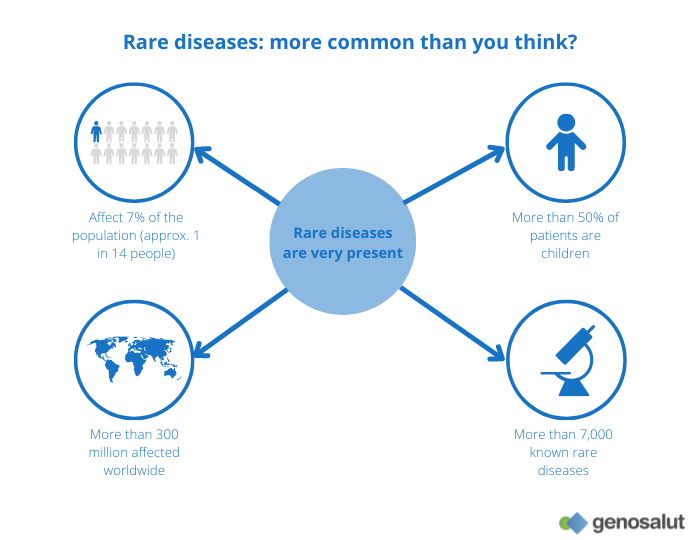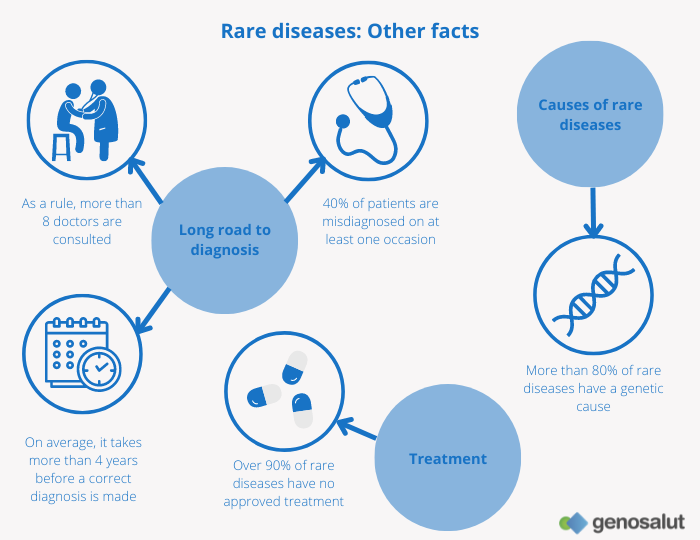Rare diseases pose a challenge for physicians. However, in recent years, two very important diagnostic support tools have taken hold: exome and genome analysis. These technologies make it possible to determine the cause in a considerable proportion (up to 40%) of undiagnosed patients, and more importantly, often with findings that allow therapeutic measures to be taken to tackle the disease.
What are rare diseases?
A rare disease is a disease that affects fewer than 5 in 10,000 people. However, given that there are between 6,000 and 8,000 different rare diseases, it is estimated that in total around 5 percent of the population suffers from a rare disease of varying severity. In other words, when considered individually they are “rare”, when considered as a whole, they are not so “rare”.

Why do they pose a diagnostic challenge?
Since there are very few cases of each individual rare disease, most physicians, especially general practitioners, are not confronted with a defined rare disease during their professional career. This fact significantly conditions the diagnosis, as in most cases they do not immediately think of a rare disease, but rather of an unusual course of a common disease.
As a rule, the diagnostic process is based on the collection of symptoms and findings that lead to a clinical picture which is compared with reference clinical pictures. And this is where the problem arises for the diagnosis of rare diseases, as the clinical pictures for rare diseases: are poorly known, are complicated by their number and diversity, or even do not exist (if it is a disease not yet described).
“Diagnostic odyssey: most people suffering from a rare disease take 4 years to obtain a diagnosis and in 20% of cases it takes up to ten years”.

As a result, rare diseases are often diagnosed late and sometimes not even diagnosed at all. However, correct diagnosis is indispensable in medicine in order to be able to take further action.
“Diagnostic delay leads to multiple consequences, such as aggravation of the pathology (which could have been avoided or at least alleviated in some cases) but also emotional, occupational and financial consequences for patients’ families.”
The importance of genetics in rare diseases
Most rare diseases (around 80%) have their origin in a genetic cause, known as a mutation. These mutations can affect a single gene (monogenic diseases) or variable sized sections of a chromosome (deletions, duplications, inversions).
External environmental influences (difficult birth, infections, accidents, environmental influences, etc.) are not among the main causes of rare diseases although they do have an influence on their appearance and progression.
Exome and genome: tools that can put an end to the diagnostic odyssey
Currently, exome and genome analysis are the most successful diagnostic tools for rare diseases. Especially in cases where symptomatology, traits and the family tree cannot be associated with a specific rare disease.
This is because they are genetic studies that allow the analysis of all the genes of an individual (exome) or all the nuclear DNA of an individual (genome). In this way, the probability of identifying the mutation or mutations that may be the cause of the rare disease is significantly increased.
At Genosalut we have more than 10 years of experience in exome and genome analysis and genetic counselling for rare diseases.
If you like our blog, subscribe to our newsletter


